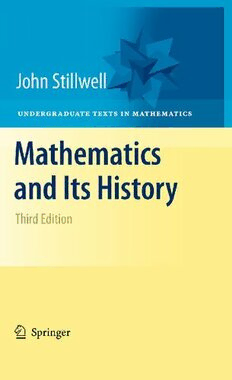
Mathematics and Its History PDF
Preview Mathematics and Its History
Undergraduate Texts in Mathematics EditorialBoard S.Axler K.A.Ribet Forothertitlespublishedinthisseries,goto http://www.springer.com/series/666 John Stillwell Mathematics and Its History Third Edition 123 JohnStillwell DepartmentofMathematics UniversityofSanFrancisco SanFrancisco,CA94117-1080 USA [email protected] EditorialBoard S.Axler K.A.Ribet MathematicsDepartment MathematicsDepartment SanFranciscoStateUniversity UniversityofCaliforniaatBerkeley SanFrancisco,CA94132 Berkeley,CA94720-3840 USA USA [email protected] [email protected] ISSN0172-6056 ISBN978-1-4419-6052-8 e-ISBN978-1-4419-6053-5 DOI10.1007/978-1-4419-6053-5 SpringerNewYorkDordrechtHeidelbergLondon LibraryofCongressControlNumber:2010931243 MathematicsSubjectClassification(2010):01-xx,01Axx (cid:2)c SpringerScience+BusinessMedia,LLC2010 Allrightsreserved.Thisworkmaynotbetranslatedorcopiedinwholeorinpartwithoutthewritten permissionofthepublisher(SpringerScience+Business Media,LLC,233SpringStreet,NewYork, NY10013,USA),exceptforbriefexcerptsinconnectionwithreviewsorscholarlyanalysis.Usein connectionwithanyformofinformationstorageandretrieval, electronicadaptation,computersoft- ware,orbysimilarordissimilarmethodologynowknownorhereafterdevelopedisforbidden. Theuseinthispublicationoftradenames,trademarks,servicemarks,andsimilarterms,evenifthey arenotidentifiedassuch,isnottobetakenasanexpressionofopinionastowhetherornottheyare subjecttoproprietaryrights. Printedonacid-freepaper SpringerispartofSpringerScience+BusinessMedia(www.springer.com) ToElaine,Michael,andRobert Preface to the Third Edition The aim of this book, announced in the first edition, is to give a bird’s- eye view of undergraduate mathematics and a glimpse of wider horizons. The second edition aimed to broaden this view by including new chapters on number theory and algebra, and to engage readers better by including manymoreexercises. Thisthird(andpossiblylast)editionaimstoincrease breadthanddepth,butalsocohesion, byconnectingtopicsthatwereprevi- ouslystrangerstoeachother,suchasprojectivegeometryandfinitegroups, andanalysis andcombinatorics. Therearetwonew chapters, onsimple groups and combinatorics, and severalnewsectionsinoldchapters. Thenewsectionsfillgapsandupdate areas where there has been recent progress, such as the Poincare´ conjec- ture. The simple groups chapter includes some material on Lie groups, thus redressing one of the omissions I regretted in the first edition of this book. Thecoverageofgrouptheory hasnowgrownfrom17pagesand10 exercises inthefirsteditionto61pagesand85exercisesinthisone. Asin the second edition, exercises often amount toproofs ofbigtheorems, bro- ken down into small steps. In this way we are able to cover some famous theorems, such as the Brouwer fixed point theorem and the simplicity of A ,thatwouldotherwiseconsumetoomuchspace. 5 Eachchapternowbeginswitha“Preview”intendedtoorientthereader withmotivation,anoutlineofitscontentsand,whererelevant,connections to chapters that come before and after. I hope this will assist readers who liketohaveanoverview before plunging intothedetails, andalsoinstruc- tors looking for a path through the book that is short enough for a one- semester course. Many different paths exist, at many different levels. Up to Chapter 10, the level should be comfortable for most junior or senior undergraduates; afterthat,thetopicsbecomemorechallenging, butalsoof greater currentinterest. vii viii PrefacetotheThirdEdition Allthefigures havenow beenconverted toelectronic form, whichhas enabledmetoreducesomethatwereexcessivelylarge,andhencemitigate thebloating thattendstooccurinneweditions. Someofthe new material on mechanics in Section 13.2 originally ap- peared (in Italian) in a chapter I wrote for Volume II of LaMatematica, edited by Claudio Bartocci and Piergiorgio Odifreddi (Einaudi, Torino, 2008). Likewise, the new Section 8.6 contains material that appeared in mybookTheFourPillarsofGeometry (Springer, 2005). Finally,therearemanyimprovementsandcorrections suggestedtome by readers. Special thanks go to France Dacar, Didier Henrion, David Kramer, Nat Kuhn, Tristan Needham, Peter Ross, John Snygg, Paul Stan- ford, Roland van der Veen, and Hung-Hsi Wu for these, and to my son Robertandmywife,Elaine,fortheirtirelessproofreading. IalsothanktheUniversityofSanFranciscoforgivingmetheopportu- nitytoteachthecoursesonwhichmuchofthisbookisbased,andMonash Universityfortheuseoftheirfacilities whilerevisingit. JohnStillwell MonashUniversity andtheUniversityofSanFrancisco March2010 Preface to the Second Edition ThiseditionhasbeencompletelyretypedinLATEX,andmanyofthefigures redoneusingthePSTrickspackage,toimproveaccuracyandmakerevision easier inthefuture. Intheprocess, severalsubstantial additions havebeen made. • Therearethreenewchapters, onChineseandIndiannumbertheory, on hypercomplex numbers, and on algebraic number theory. These fill some gaps in the first edition and give more insight into later developments. • Therearemanymoreexercises. This,Ihope,correctsaweaknessof thefirstedition,whichhadtoofewexercises,andsomethatweretoo hard. Some of the monster exercises in the first edition, such as the one in Section 2.2 comparing volume and surface area of the icosa- hedron and dodecahedron, have now been broken into manageable parts. Nevertheless, there are still a few challenging questions for thosewhowantthem. • Commentary has been added to the exercises to explain how they relate to the preceding section, and also (when relevant) how they foreshadow latertopics. • The index has been given extra structure to make searching easier. Tofind Euler’s work on Fermat’s last theorem, for example, one no longer has to look at 41 different pages under “Euler.” Instead, one canfindtheentry“Euler,andFermat’slasttheorem”intheindex. • The bibliography has been redone, giving more complete publica- tiondataformanyworkspreviously listedwithlittleornone. Ihave found the online catalogue of the Burndy Library of the Dibner In- stitute at MIT helpful in finding this information, particularly for ix x PrefacetotheSecondEdition early printed works. Forrecent works I have made extensive use of MathSciNet,theonlineversionofMathematical Reviews. There are also many small changes, some prompted by recent mathe- matical events, such as the proof of Fermat’s last theorem. (Fortunately, this one did not force a major rewrite, because the background theory of ellipticcurveswascoveredinthefirstedition.) I thank the many friends, colleagues, and reviewers who drew my at- tentiontofaultsinthefirstedition,andhelpedmeintheprocessofrevision. Specialthanks gotothefollowingpeople. • My sons, Michael and Robert, who did most of the typing, and my wife,Elaine,whodidagreatdealoftheproofreading. • My students in Math 310 at the University of San Francisco, who triedoutmanyoftheexercises,andtoTristanNeedham,whoinvited metoUSFinthefirstplace. • MarkAarons,DavidCox,DuaneDeTemple,WesHughes,Christine Muldoon, Martin Muldoon, and Abe Shenitzer, for corrections and suggestions. JohnStillwell MonashUniversity Victoria, Australia 2001 Preface to the First Edition One of the disappointments experienced by most mathematics students is thattheynevergetacourseonmathematics. Theygetcourses incalculus, algebra, topology, andsoon,butthedivisionoflaborinteaching seemsto prevent these different topics from being combined into a whole. In fact, some of the most important and natural questions are stifled because they fall on the wrong side of topic boundary lines. Algebraists do not discuss thefundamental theorem ofalgebra because “that’s analysis” andanalysts do not discuss Riemann surfaces because “that’s topology,” for example. Thusifstudents aretofeeltheyreally knowmathematics bythetimethey graduate, thereisaneedtounifythesubject. Thisbookaimstogiveaunifiedviewofundergraduatemathematicsby approaching thesubject through itshistory. Sincereaders should havehad somemathematical experience, certain basics areassumed andthemathe- matics is not developed formally as in a standard text. Onthe other hand, themathematicsispursuedmorethoroughly thaninmostgeneralhistories of mathematics, because mathematics is our main goal and history only the means of approaching it. Readers are assumed to know basic calcu- lus,algebra,andgeometry,tounderstandthelanguageofsettheory,andto have met some more advanced topics such as group theory, topology, and differential equations. Ihave tried to pick outthe dominant themes ofthis body of mathematics, and to weave them together as strongly as possible bytracingtheirhistorical development. Indoingso, Ihavealsotried totieupsometraditional loose ends. For example, undergraduat√es can solve quadratic equations. Why not√cubics? They can integrate 1/ 1− x2 but are told not to worry about 1/ 1− x4. Why? Pursuing thehistory ofthese questions turnsout tobeveryfruitful, leading to a deeper understanding of complex analysis and algebraic ge- ometry, among other things. Thus I hope that the book will be not only a xi
